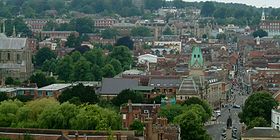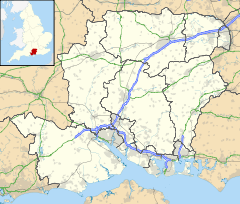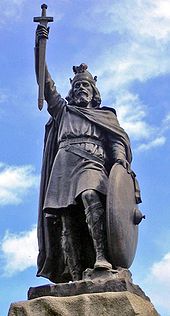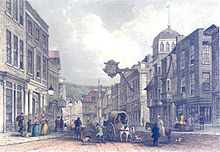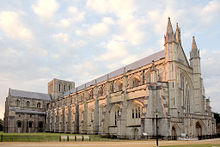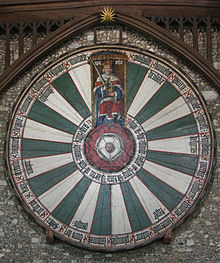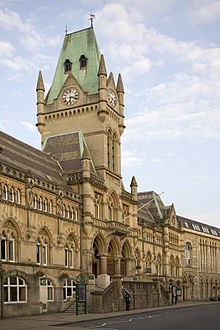- Winchester
-
Coordinates: 51°03′48″N 1°18′31″W / 51.0632°N 1.3085°W
Winchester
A view of Winchester city centre
 Winchester shown within Hampshire
Winchester shown within HampshirePopulation 41,420 [1] OS grid reference SU485295 District Winchester Shire county Hampshire Region South East Country England Sovereign state United Kingdom Post town WINCHESTER Postcode district SO22, SO23 Dialling code 01962 Police Hampshire Fire Hampshire Ambulance South Central EU Parliament South East England UK Parliament Winchester List of places: UK • England • Hampshire Winchester (archaically known as Winton and Wintonceastre) is a historic cathedral city and former capital city of England. It is the county town of Hampshire, in South East England. The city lies at the heart of the wider City of Winchester, a local government district, and is located at the western end of the South Downs, along the course of the River Itchen.[2] At the time of the 2001 Census, Winchester had a population of 41,420.[1]
Winchester developed from the Roman town of Venta Belgarum. Winchester's major landmark is Winchester Cathedral, one of the largest cathedrals in Europe, with the distinction of having the longest nave and overall length of all Gothic cathedrals in Europe. The town is also home to the University of Winchester and the famous public school, Winchester College. The city's architectural and historic interest, and its fast links to other towns and cities have led Winchester to become one of the most expensive and desirable areas of the country.[3] A person who is from or resides in Winchester is sometimes locally known as a Wintonian.
Contents
History
Early history
Settlement in the area dates back to pre-Roman times, with an Iron Age enclosure or valley fort, Oram's Arbour, on the western side of the present-day city. After the Roman conquest of Britain the civitas, then named Venta Belgarum or "Market of the Belgae", was of considerable importance.[4]
At the beginning of the 3rd century Winchester was given protective stone walls.[5] At around this time the city had covered an area of 144 acres (58 ha), which made it the 5th largest town in Roman Britain. There were also a small number of suburbs outside the walls.[6] However, like many other Roman towns, Winchester began to decline in the 4th century.[7]
Anglo-Saxon times
The city has historic importance as it replaced Dorchester-on-Thames as the de facto capital of the ancient kingdom of Wessex in about 686 after King Caedwalla of Wessex defeated King Atwald of Wight. Although it was not the only town to have been the capital, it was established by King Egbert as the main city in his kingdom in 827. Saint Swithun was Bishop of Winchester in the mid 9th century. The Saxon street plan laid out by Alfred the Great is still evident today: a cross shaped street system which conformed to the standard town planning system of the day – overlaying the pre-existing Roman street plan (incorporating the ecclesiastical quarter in the south-east; the judicial quarter in the south-west; the tradesmen in the north-east). The town was part of a series of fortifications along the south coast. Built by Alfred to protect the Kingdom, they were known as 'burhs'. The medieval city walls, built on the old Roman walls, are visible in places. Only one section of the original Roman walls remains. Four main gates were positioned in the north, south, east and west plus the additional Durngate and King's Gate. Winchester remained the capital of Wessex, and then England, until some time after the Norman Conquest when the capital was moved to London. The Domesday Book was compiled in the city late in the reign of William the Conqueror.
Medieval and later times
A serious fire in the city in 1141 accelerated its decline. However, William of Wykeham (1320–1404) played an important role in the city's restoration. As Bishop of Winchester he was responsible for much of the current structure of the cathedral, and he founded the still extant public school Winchester College. During the Middle Ages, the city was an important centre of the wool trade, before going into a slow decline. The curfew bell in the bell tower (near the clock in the picture), still sounds at 8.00pm each evening. The curfew was the time to extinguish all home fires until the morning
In 1770, Thomas Dummer purchased the City Cross (also known as the Buttercross) from the Corporation of Winchester, intending to have it re-erected at Cranbury Park, near Otterbourne. When his workmen arrived to dismantle the cross, they were prevented from doing so by the people of the city, who "organised a small riot"[8] and they were forced to abandon their task. The agreement with the city was cancelled and Dummer erected a lath and plaster facsimile, which stood in the park for about sixty years before it was destroyed by the weather.[9] The Buttercross still stands in the High Street.
The famous novelist Jane Austen died in Winchester on 18 July 1817 and is buried in the cathedral. The Romantic poet John Keats stayed in Winchester from mid-August to October 1819. It was in Winchester that Keats wrote "Isabella", "St. Agnes' Eve", "To Autumn" and "Lamia". Parts of "Hyperion" and the five-act poetic tragedy "Otho The Great" were also written in Winchester.
Further learning
The City Museum located on the corner of Great Minster Street and The Square contains much information on the history of Winchester. Early examples of Winchester measures of standard capacity are on display.
Governance
Winchester is currently represented in the House of Commons through the Winchester Parliamentary Constituency by Steve Brine of the Conservatives who in the General Election of 2010 beat Martin Tod, the Liberal Democrat candidate, by 3048 votes (a margin of 5.4%).[10] Mark Oaten had previously won the seat for the Liberal Democrats during the 1997 general election in which he defeated Gerry Malone, a Health Minister in John Major's Conservative Government.
Elections to the city council take place in three out of every four years, with one third of the councillors elected in each election. Since winning a majority in the 2006 election the council had been controlled by the Conservatives,[11] until the 2010 election when the council was again controlled by the Liberal Democrats.
Landmarks
Cathedral
Winchester Cathedral, the longest cathedral in Europe, was originally built in 1079. It contains much fine architecture spanning the 11th to the 16th century and is the place of interment of numerous Bishops of Winchester (such as William of Wykeham), Anglo-Saxon monarchs (such as Egbert of Wessex) and later monarchs such as King Canute and William Rufus,[12] as well as Jane Austen. It was once an important pilgrimage centre and housed the shrine of Saint Swithun. The ancient Pilgrims' Way travelling to Canterbury begins at Winchester. The plan of the earlier Old Minster is laid out in the grass adjoining the cathedral. The New Minster (original burial place of Alfred the Great and Edward the Elder[12]) once stood beside it. It has a girls choir and a boys choir, which sing on a regular basis at the cathedral.
The Winchester Cathedral Close contains a number of historic buildings from the time when the cathedral was also a priory. Of particular note are the Deanery which dates back to the thirteenth century. It was originally the Prior's House, and was the birthplace of Arthur, Prince of Wales in 1486. Not far away is Cheyney Court, a mid fifteenth century timber framed house incorporating the Porter's Lodge for the Priory Gate. It was the Bishop's court house.
The earliest hammer-beamed building still standing in England is also situated in the Cathedral Close, next to the Dean's garden. It is known as the Pilgrims' Hall, as it was part of the hostelry used to accommodate the many pilgrims to Saint Swithun's shrine. Left-overs from the lavish banquets of the Dean would be given to the pilgrims who were welcome to spend the night in the hall. It is thought by Winchester City Council to have been built in 1308. Now part of The Pilgrims' School, the hall is used by the school for assemblies in the morning, drama lessons, plays, orchestral practices, Cathedral Waynflete rehearsals, the school's Senior Commoners' Choir rehearsals and so forth.
Wolvesey Castle and Palace
Wolvesey Castle was the Norman bishop's palace, dating from 1110, but standing on the site of an earlier Saxon structure. It was enhanced by Henry de Blois during the Anarchy of his brother King Stephen's reign. He was besieged there for some days. In the 16th century, Queen Mary Tudor and King Philip II of Spain were guests just prior to their wedding in the Cathedral. The building is now a ruin (maintained by English Heritage), but the chapel was incorporated into the new palace built in the 1680s, only one wing of which survives.
Castle
Winchester is well known for the Great Hall of its castle, which was built in the 12th century. The Great Hall was rebuilt, sometime between 1222 and 1235, and still exists in this form. It is famous for King Arthur's Round Table, which has hung in the hall from at least 1463. The table actually dates from the 13th century, and as such is not contemporary to Arthur. Despite this it is still of considerable historical interest and attracts many tourists. The table was originally unpainted, but was painted for King Henry VIII in 1522. The names of the legendary Knights of the Round Table are written around the edge of the table surmounted by King Arthur on his throne. Opposite the table are Prince Charles' 'Wedding Gates'. In the grounds of the Great Hall is a recreation of a medieval garden. Apart from the hall, only a few excavated remains of the stronghold survive amongst the modern Law Courts. The buildings were supplanted by the King's House, now incorporated into the Peninsula Barracks where there are several military museums. Winchester is also home to the Army Training Regiment Winchester, otherwise known as Sir John Moore Barracks, where Army recruits undergo their phase one training.
Hospital of St Cross
The almshouses and vast Norman chapel of Hospital of St Cross were founded just outside the city centre by Henry de Blois in the 1130s. Since at least the 14th century, and still available today, a 'wayfarer's dole' of ale and bread has been handed out there. It was supposedly instigated to aid pilgrims on their route through to Canterbury.
Other buildings
Other important historic buildings include the Guildhall dating from 1871 in the Gothic revival style,[13] the Royal Hampshire County Hospital designed by William Butterfield and Winchester CIty Mill, one of the city's several water mills driven by the River Itchen that run through the city centre. The mill has recently been restored, and is again milling corn by water power. It is owned by the National Trust.
Although Winchester City survived World War II intact, about thirty percent of the Old Town was demolished to make way for buildings more suited to modern office day requirements (in particular for Hampshire County Council and Winchester City Council). Since the late 1980s the city has seen a gradual replacement of these post war brutalist structures for contemporary developments more sympathetic to the medieval urban fabric of the Old Town.
Education
There are numerous educational institutions in Winchester.
There are three state secondary schools: Kings' School Winchester, The Westgate School, and The Henry Beaufort School, all of which have excellent reputations. The sixth form Peter Symonds College is the main college that serves Winchester; it is rated amongst the top and the largest sixth form colleges in the UK.
Among independent junior/preparatory schools, there are The Pilgrims' School Winchester, Twyford School, Prince's Mead School etc. Winchester College, which accepts students from ages 13 to 18, is one of the best-known independent schools in Britain and many of its pupils leave for well-respected universities. St Swithun's is an independent school for girls which frequently appears on the league tables for GCSE and A-level results.
University of Winchester
The University of Winchester (formerly King Alfred's College) is a public university based in Winchester and the surrounding area. The University origins go back as far as 1840 - originally as a Diocesan Training centre. Winchester's university first began as a teacher training college. It is located on a purpose built campus near the city centre. The Winchester School of Art is part of the University of Southampton.
Winchester College
The buildings of Winchester College, a public school founded by William of Wykeham, still largely date from their first erection in 1382. There are two courtyards, a gatehouse, cloister, hall, a large college chapel and it also owns "The Water Meadows" through which runs a part of the River Itchen. It was planned to educate poor boys before they moved on to New College, Oxford and often a life in the church.
Sport
Winchester has an association football league and two recognised clubs, Winchester City F.C., the 2004 FA Vase winners who were founded in 1884 and has the motto "Many in Men, One in Spirit", currently play in the Southern League, Division 1 S&E after a highly successful spell in the Wessex League and Winchester Castle F.C., who have played in the Hampshire League since 1971. Reading midfielder Brian Howard was born in Winchester, as was Doncaster Rovers and Wales international midfielder Brian Stock. The main Winchester 5 a side football team are Winchester Allstars, who play at Fleming Park, Eastleigh.
Winchester women also have successful sports teams with Winchester City Women FC currently playing in the Hampshire County League Division 1 and recently went through a league campaign unbeaten. The club caters for players of all ability and ages. [1]
Winchester also has a rugby union team named Winchester RFC and a thriving athletics club called Winchester and District AC.
Winchester has a thriving successful Hockey Club,[14] with ten men's and three ladies' teams catering to all ages and abilities.
The city has a growing roller hockey team which trains at River Park Leisure Centre.
Lawn bowls is played at several greens (the oldest being Hyde Abbey dating from 1812) during the summer months and at Riverside Indoor Bowling Club during the winter.
Winchester College invented and lent its name to Winchester College Football, played exclusively at the College and in some small African/South American communities.
Winchester also has a 5 a side team known as the Winchester Allstars, who currently play in Leisure Leagues Eastleigh.
Transport
Winchester is located on the M3 motorway and at the meeting of the A34, A31, A3090 and A272 roads. Once a major traffic bottleneck, it still suffers from congestion at peak times. It is just to the south of the A303 and A30.
Winchester railway station is served by South West Trains trains from London Waterloo, Weymouth, Portsmouth and Southampton, and by CrossCountry Trains between Bournemouth, Southampton, Reading, Oxford and either Manchester or Newcastle. Historically it was also served by the Didcot, Newbury and Southampton Railway (closed in the 1960s) and by a line to London via Alton which partially survives as the Watercress Line.
Local and Park and Ride bus services are provided by Stagecoach, who also run routes to Andover, New Alresford, Alton, Petersfield, Romsey, Salisbury, Hursley, Fareham and Southampton. Other services run to Eastleigh, Southampton and Chandler's Ford (Bluestar), to Romsey and Stockbridge (Wilts & Dorset), to Broughton and West Meon (community buses), to Swanmore and Bishops Waltham (Brijan Tours). Many services are subsidised by Hampshire County Council. National Express coaches serve Bournemouth, Poole, Portsmouth, Heathrow Airport, Oxford and Edinburgh. Megabus and Greyhound serve Birmingham, Oxford, Manchester and Leeds.[15]
Winchester is at the head of the Itchen Navigation, which once provided a transport link to Southampton, but has recently been restored as a wildlife corridor.
Law courts
Winchester Combined Court Centre consists of a Crown Court and County Court. It is administered by Her Majesty's Courts Service, an Executive Agency of the Ministry of Justice. Winchester is a first-tier court centre and is visited by High Court judges for criminal and also for civil cases (in the District Registry of the High Court). One of the most high profile case to be heard here was the Rose West murder trial in 1995.
Winchester also has a separate District Probate registry which is part of the High Court.[16]
Media and culture
Since 1974 Winchester has hosted the annual Hat Fair, a celebration of street theatre that includes performances, workshops, and gatherings at several venues around the city.
Winchester hosts one of the UK's largest and most successful farmers' markets, with close to – or over – 100 stalls, and is certified by FARMA. The farmers' market takes place on the second and last Sunday monthly in the town centre.
On the Channel 4 television programme The Best And Worst Places To Live In The UK, which was broadcast on 26 October 2006, Winchester was branded as the "Best Place in the UK to Live in: 2006".[3] In the 2007 edition of the same programme, Winchester had dropped to second best place to live, behind Edinburgh.
In 2003, Winchester was ranked 5th in a league of 50 'crap towns' in the UK nominated by readers of Idler magazine.[17]
A number of public figures and celebrities were students at Peter Symonds College in Winchester, including; TV presenter and model Alexa Chung, Andy Burrows - singer/song writer and drummer of band Razorlight, glamour model Lucy Pinder and comedian Jack Dee, among others.
The Punk Rock singer-song writer Frank Turner comes from Winchester, a fact that he often mentions at concerts as well as in his songs.
The band Polly and the Billets Doux formed in Winchester, and are still based there now.
Actor Colin Firth is from Winchester and was educated at Kings' school.
2011 sees Winchester's first ever Oxjam Takeover music festival, on Saturday 22nd October.[18]
Winchester in fiction
Medieval
In the medieval narrative poem, Sir Orfeo, the main character Sir Orfeo is King of Winchester, which is said to be the modern name of Thrace. The final combat of the romance hero Guy of Warwick against the giant Colbrand takes place outside the walls of Winchester.
19th century
A scene in Henry Esmond (1852) by William Makepeace Thackeray is set in the choir of Winchester cathedral. Winchester is in part the model for Barchester in the Barsetshire novels of Anthony Trollope, who attended Winchester College; The Warden (1855) is said to be based on a scandal at the Hospital of St Cross. A fictionalised Winchester appears as Wintoncester in Hardy's Tess of the d'Urbervilles (1891). Some of the action in Sir Arthur Conan Doyle's The Adventure of the Copper Beeches (1892) takes place in the city.
20th century
A fictitious estate near Winchester is the scene of a crime in the Sherlock Holmes adventure, The Problem of Thor Bridge (1922).
In Gerry Anderson's 1967 and 1968 programme Captain Scarlet and the Mysterons, background material published by, or with the approval of, Anderson identifies Winchester as the birthplace of the main character, Captain Scarlet, real name Paul Metcalfe.[citation needed]
Winchester is the main location of John Christopher's post-apocalyptic science fiction series, Sword of the Spirits. Winchester Cathedral is featured in James Herbert's horror novel The Fog. The Siege of Winchester in 1141, part of the English Civil War between King Stephen and the Empress Matilda, is an important plot element in the detective novel An Excellent Mystery, part of the Brother Cadfael chronicles by Edith Pargeter writing as Ellis Peters. 12th century Winchester is one of the locations described in Ken Follett's Pillars of the Earth (1989). In Philip Pullman's novel The Subtle Knife (part of the His Dark Materials trilogy) the main male protagonist, Will Parry, comes from Winchester. However, little of the book is set there.
In the movie Merlin, King Uther's first conquest of Britain begins with Winchester, which Merlin foresaw would fall.
21st century
In the Japanese manga Death Note, The Wammy's House, an orphanage founded by Quillsh Wammy, where the detective L's successors (Mello, Near, and Matt) are raised, is located in Winchester.
International relations
Twin towns - Sister cities
Winchester is twinned with:[19]
The Winchester district is twinned with
The city is also the sister city of Winchester, Virginia. The Mayor of Winchester (UK) has a standing invitation to be a part of the Shenandoah Apple Blossom Festival in Winchester (VA) each year in the Spring. The Virginia town also takes its name from Winchester in England.
The city of Winchester gave its name to a suburb of Paris, France, called Le Kremlin-Bicêtre (23,724 inhabitants), owing to a manor built there by John of Pontoise, Bishop of Winchester, at the end of the 13th century.
See also
- List of people from Winchester
- Winchester Hat Fair
- Winchester Hoard
References
- Notes
- ^ a b KS01 Usual resident population: Census 2001, Key Statistics for urban areas. National Statistics. http://www.statistics.gov.uk/statbase/ssdataset.asp?vlnk=8272&More=Y. Retrieved 2009-04-23
- ^ Landranger 185: Winchester & Basingstoke. Ordnance Survey. 2005. ISBN 9780319228845
- ^ a b "Winchester: Best and Worst Places to Live in the UK 2006 from channel4.com/4homes". Channel4.com. http://www.channel4.com/4homes/ontv/best&worst/2006/winchester.html. Retrieved 2009-05-06.
- ^ Roman Britain.org Venta Belgarum
- ^ Winchester Roman walls
- ^ "PJO archaeology". http://www.pjoarchaeology.co.uk/academic-consultancy/report-winchester-roman-cemeteries-and-suburbs.html. Retrieved 2011-01-22.
- ^ Winchester Roman history
- ^ "The Buttercross, Winchester". City of Winchester. 1998. http://www.cityofwinchester.co.uk/history/html/buttercross.html. Retrieved 23 September 2009.
- ^ Yonge, Charlotte M. (1898). "Old Otterbourne". John Keble's Parishes – Chapter 8. www.online-literature.com. http://www.online-literature.com/charlotte-yonge/john-keble/8/. Retrieved 23 September 2009.
- ^ By Andrew Napier (May 2010). "Tories sweep in but lose control of city council". Newsquest Media Group. http://www.hampshirechronicle.co.uk/news/politics/8163003.New_MPs_reflect_on_their_victories/. Retrieved 2010-08-07.
- ^ "Winchester". BBC News Online. 2008-04-19. http://news.bbc.co.uk/1/shared/bsp/hi/elections/local_council/08/html/24up.stm. Retrieved 2010-02-04.
- ^ a b Dodson, Aidan. The Royal Tombs of Great Britain. London: Gerald Duckworth & Co. 2004.
- ^ History of Winchester Guildhall
- ^ "Winchester Hockey Club". Winchesterhc.co.uk. 2011-04-14. http://www.winchesterhc.co.uk/. Retrieved 2011-06-03.
- ^ "Winchester Bus & Train Travel Times". Hampshire County Council. 2011.
- ^ "The Probate Service - Registries". Her Majesty's Courts Service. http://www.hmcourts-service.gov.uk/infoabout/civil/probate/registries.htm. Retrieved 2010-10-10.
- ^ "UK's 'worst 50' towns revealed". BBC. 2003-10-02. http://news.bbc.co.uk/1/hi/uk/3158298.stm. Retrieved 2003-10-02.
- ^ "Oxjam Winchester Takeover". Oxjam. Oxjam Winchester. http://www.oxjamwinchestertakeover.co.uk. Retrieved 18 August 2011.
- ^ a b c "Twin Towns in Hampshire". www3.hants.gov.uk. http://www3.hants.gov.uk/localpages/twintown.htm. Retrieved 2009-11-06.
- ^ "Home". www.winchestertwinning.org.uk. http://www.winchestertwinning.org.uk/. Retrieved 2009-11-06.
External links
Ceremonial county of Hampshire Unitary authorities Boroughs or districts Major settlements - Aldershot
- Alton
- Andover
- Basingstoke
- Bishop's Waltham
- Blackwater
- Bordon
- Eastleigh
- Fareham
- Farnborough
- Fleet
- Fordingbridge
- Gosport
- Havant
- Hedge End
- Lee-on-the-Solent
- Lymington
- New Alresford
- New Milton
- Petersfield
- Portsmouth
- Ringwood
- Romsey
- Southampton
- Stockbridge
- Tadley
- Totton and Eling
- Waterlooville
- Whitchurch
- Winchester
- Yateley
See also: List of civil parishes in Hampshire
Rivers Topics Categories:- Civil parishes in Winchester
- Capitals of former nations
- Cities in South East England
- County towns in England
- Former national capitals
- Winchester
Wikimedia Foundation. 2010.

